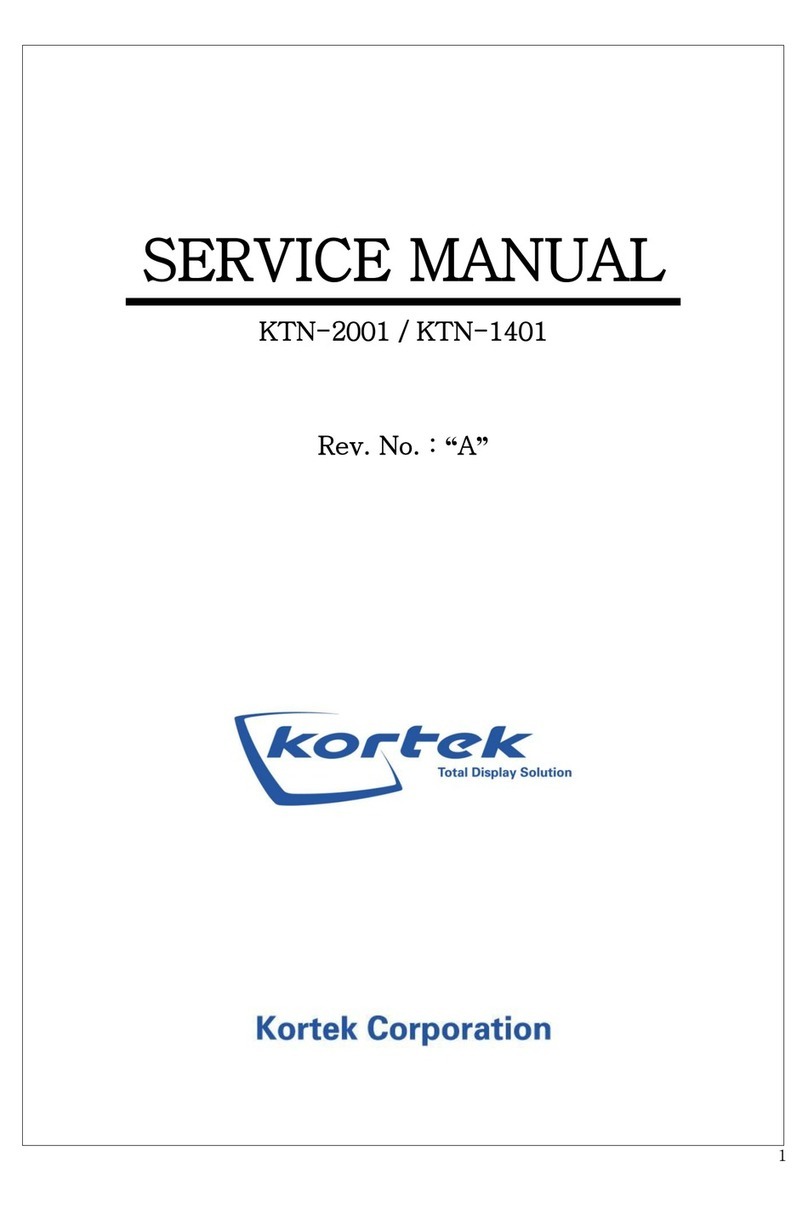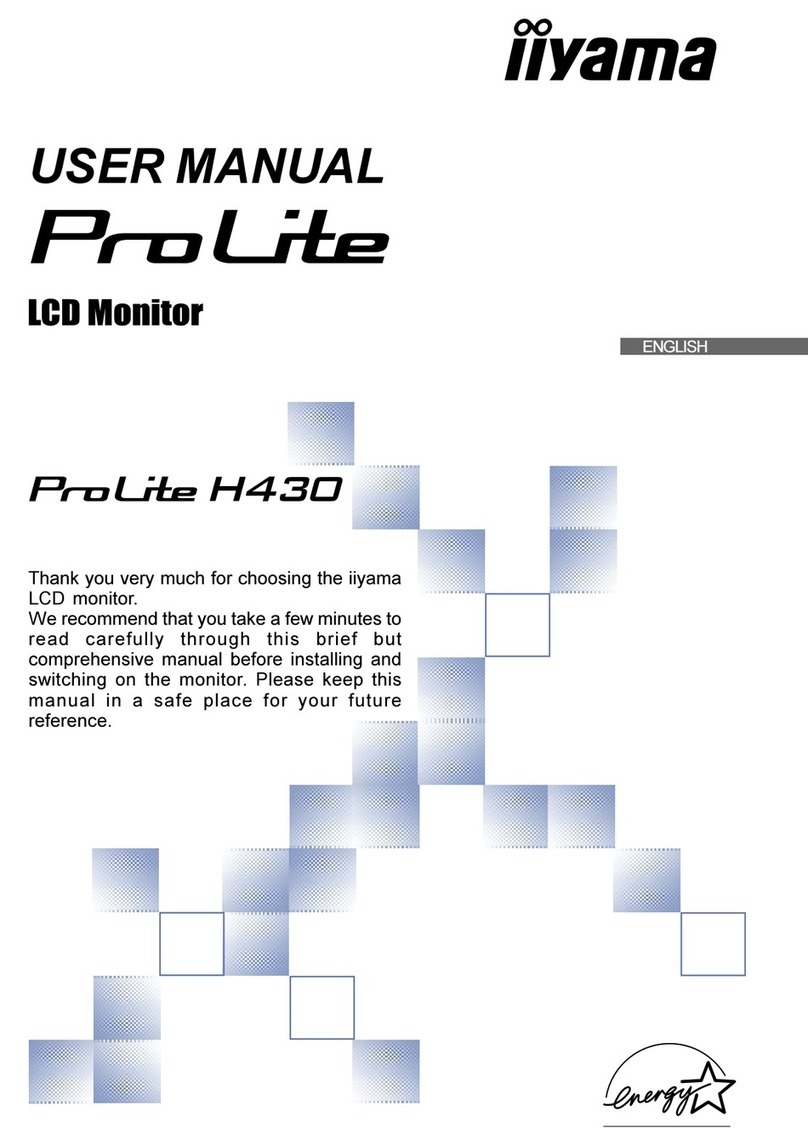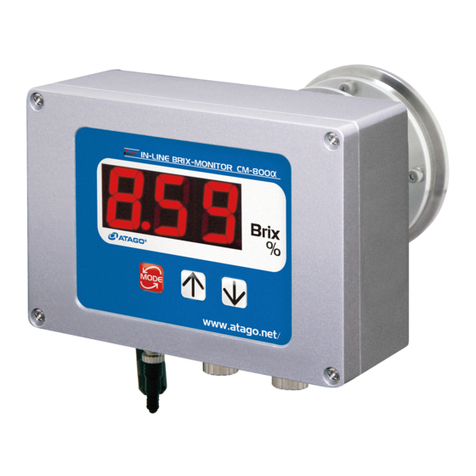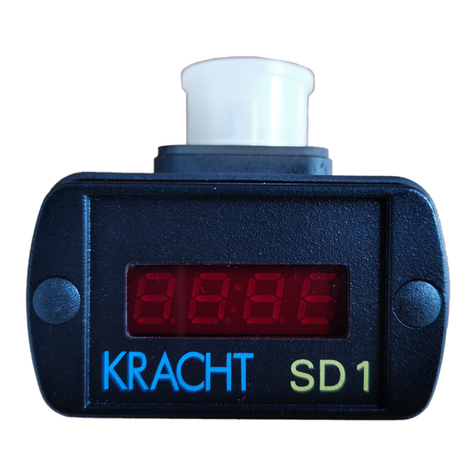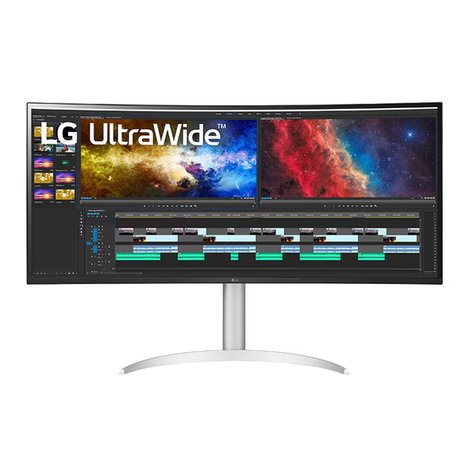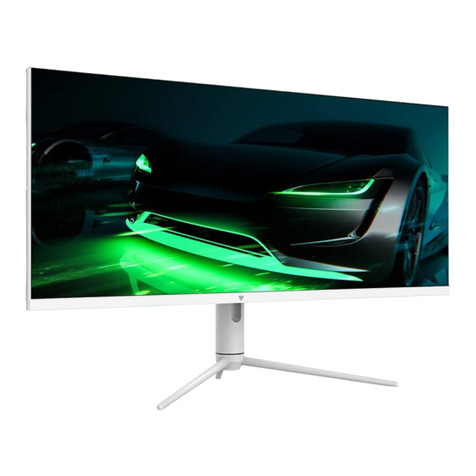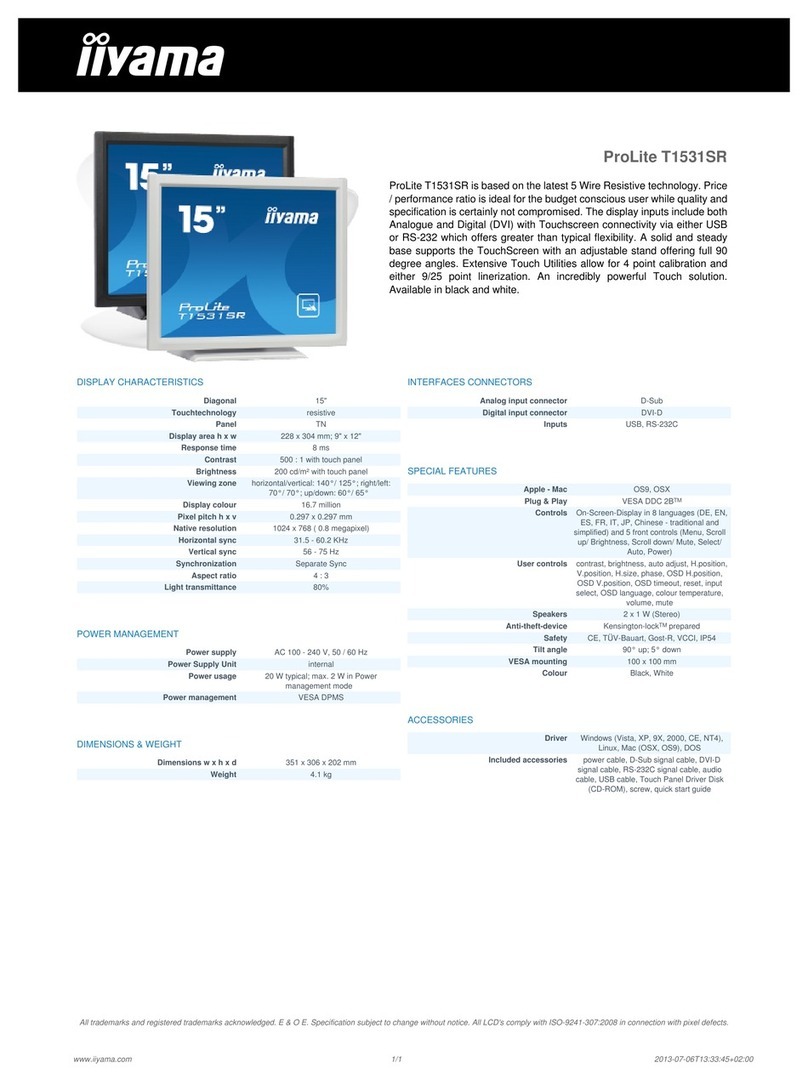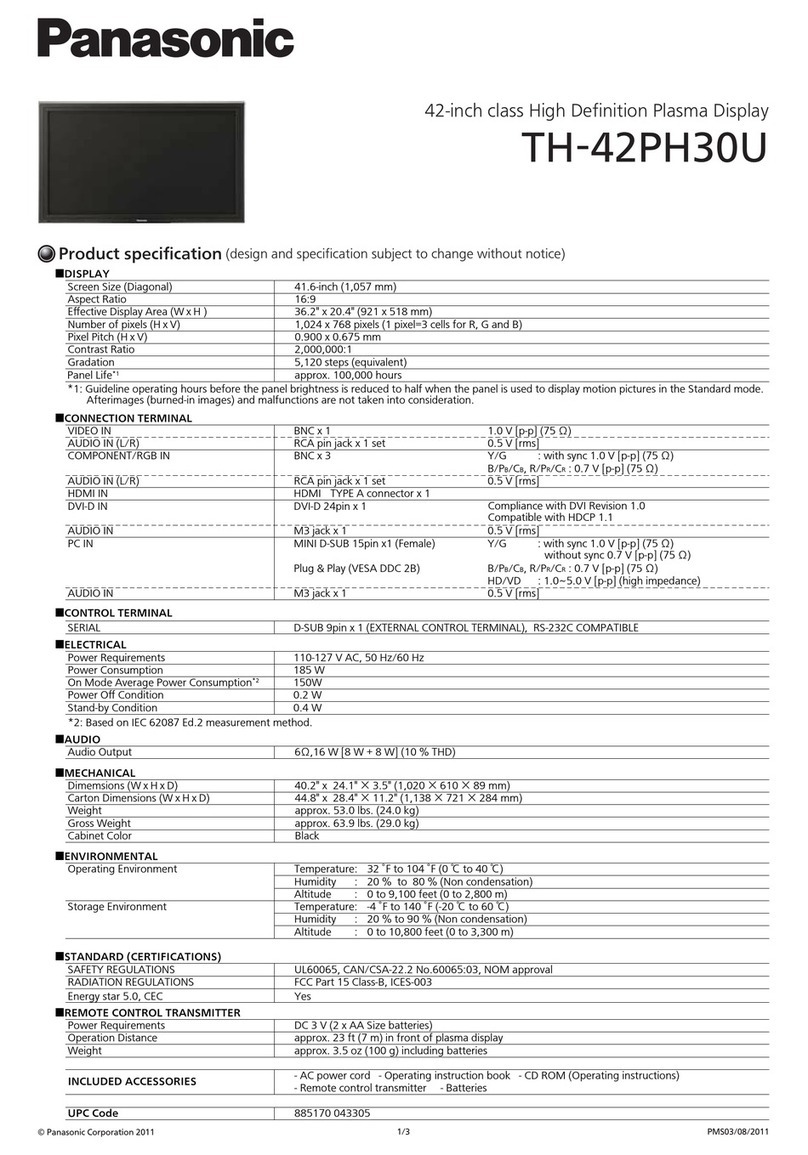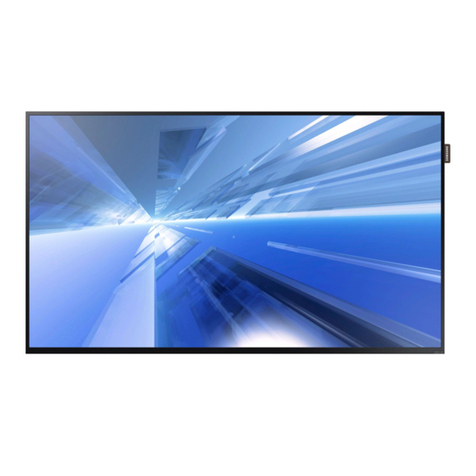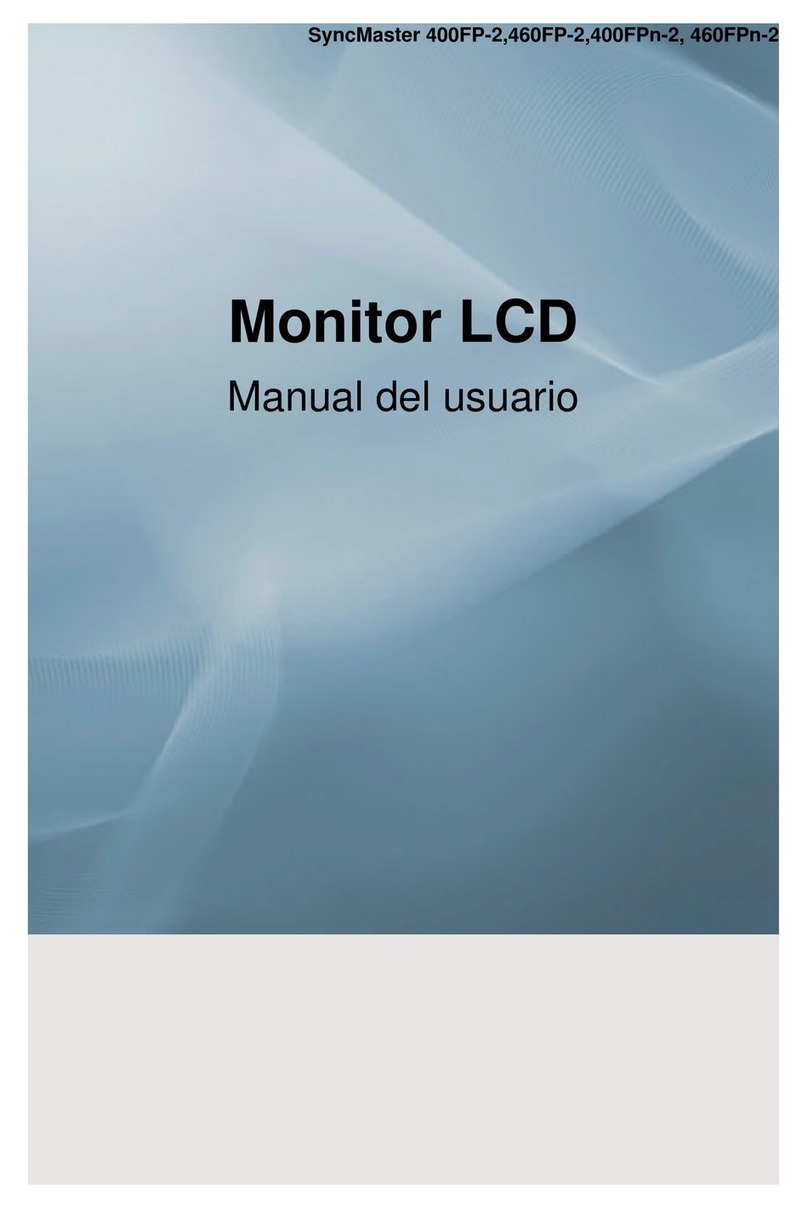Kortek KT-1903NA User manual

SERVICE MANUAL
COLOR CRT MONITOR
KT-1903NA / KT-1703NA
KT-1403NA
KORTEK CORPORATION
DOC. NO KT-XX03NA-SM
DATE 2004 .02. 02
REV. NO 0
REV. DATE -

2
CONTENTS
1.PRECAUTIONS ****** 3
2.PRODUCT SPECIFICATIONS ****** 6
3.OPERATING INSTRUCTIONS ****** 10
4.ADJUSTMENT ****** 10
5.BLOCK DIAGRAM ****** 12
6.GENERAL THEORY OF OPERATION ****** 13
7.TROUBLE SHOOTING GUIDE ****** 26
8.WAVE FORM ****** 33
9.BILL OF MATERIAL ****** 36
10.SCHEMATICS ****** 51

3
1.PRECAUTIONS
1-1 SAFETY PRECAUTIONS
WARNINGS : Service should not be attempted by anyone unfamiliar with the necessary
precautions on this monitor. The following precautions are necessary during
servicing.
1) For continued safety, do not attempt to modify the circuit board.
2) Disconnect the AC Power before servicing.
3) When the Monitor is operating, do not touch any heatsink on the Chassis as it is self-heated.
1-1-1 FIRE & SHOCK HARZARD
1) During servicing, pay attention to the original wires whether it is uncoated or undressed,
especially the wires in the high voltage circuit section. If there is any uncoated or melted
wire is found, then please do not try to replace the related parts, and wait for the qualified
service person's coming.
2) Many electrical, mechanical parts in this monitor have special safety-related characteristics for
protection against shock hazard and others. These characteristics are often passed unnoticed
by a visual inspection and the protection afforded by them cannot necessarily be obtained
by using replacement components rated for higher voltage wattage,etc.
Replacement parts which have these special characteristics are identified in the manual and
supplements by shading on the schematic diagram and the parts list.
3) When replacing Chassis, always be certain that all the protective devices are installed
properly.
4) leakage current check (figure 1)
KORTEK Corporation
KT-XX03NA

4
(TEST METHODE)
1-1-2. X-RADIATION
WARNING : The only potential source of x-radiation is the picture tube, however
when the high voltage. Circuitry is operating properly, there is no possibility
of an x-radiation problem. The basic precaution is to keep the high voltage
at the factory recommended level.
1) To measure the high voltage, use a high-impedance high-voltage meter.
Connect(-) to chassis and (+) to the CRT anode cap.
2) Turn the contrast control max. clockwise.
3) Measure the high voltage. The high voltage meter should indicate the following factory
recommended level
4) If the actual level exceeds the max. factory set level, then immediate service is required to
prevent the possibility of premature failure of components
5) To prevent X-RADIATION possibility, it is essential to use the specified picture tube.
6) The nominal high voltage is 24KV and not exceed 27KV at zero beam current at rated voltage.
KORTEK Corporation
KT-XX03NA
DEVICE
UNDER
TEST LEAKAGE CURRENT
TESTER
READING SHOULD
NOT BE ABOVE 0.45mA
TEST ALL
EXPOSED METAL
SURFACES
2-WIRE
CORD
ALSO TEST WITH PLUG
REVERSED(USING AC
ADAPTER PLUG AS
REQUIRED)
EARTH
GROUND
Figurel 1

5
1-2. SERVICING PRECAUTION
WARNING 1 : First, reading "safety precaution" section of this manual. If unforeseen
circumstances create conflict between the servicing precautions and safety
precaution, always follow the safety precautions.
WARNING 2 : A high voltage VR replaced in the wrong direction may cause excessive
X-RAY Emitting.
WARNING 3 : An electrolytic capacitor installed which the wrong polarity might explode.
1) Servicing precautions are printed on the label, and should be followed closely.
2) Always unplug the AC power cord from the AC power source before attempting to remove
or reinstall any component or assembly, disconnect PCB plugs or connectors, connect all test
Components in parallel which an electrolytic capacitor.
3) After servicing, always check that the screw, components and wiring have been correctly
reinstalled. Make sure that the area around the serviced part has not been demaged.
4) Check the insulation between the blades of the AC plug and accessible conductive
parts(example : metal parts, input terminals)
5) Never touch any of the locked B+ voltage. Do not apply AC power to the unit(or any of its
Assemblies) unless all solid-state heatsinks are correctly installed.
6) Always connect a test instrument's ground lead to the instrument chassis ground before
connecting the positive lead; always remove the instrument's ground lead last.
KORTEK Corporation
KT-XX03NA

6
2.Product Specifications
2-1 SPECIFICATION
PARAMETER MIN TYP MAX UNITS
OPERATING VOLTAGE 100 115/230 230 VAC
OPERATING POWER 85 90 WATTS
LEAKAGE CURRENT TO CHASSIS GND
AT250VAC,50/60Hz(LINE/NATU,IN COMMON)
< 0.40 0.45 mA
HI-POT LINE/NEUT, IN COMMON < 2.0 2.4 mA
OPERATING TEMPERATURE 10 60 DEGREE
REL,HUMIDITY OPERATING 10 90 %
MAGNETIC SHIELD INTERNAL
DEGAUSSING MANUAL TYPE
VIDEO SIGNAL +0.7Vpp, 75 Ohm MONITOR TERMINATIONS
RASTER DIM ADJUST RANGE VERTICAL < 190 > 290 mm
RASTER DIM ADJUST RANGE HORIZONTAL < 300 > 350 mm
MODE 640*480
PINCUSHION(ALL BRIGHTNESS) 3.0 %
MIS-CONVERGENCE CENTER 0.25 0.3 mm
MIS-CONVERGENCE CORNERS 0.35 0.45 mm
VERTICAL
SCAN RATE 60/70 Hz
HOLD IN RANG ±5 Hz
SYNC +5V 74LS LEVELS 5.0 5.0 VOLTAGE
LOW 0.0 0.0 0.6 VOLTAGE
NON-LINEARITY 5 %
HORIZONTAL
SCAN FREQUENCY 31.2 31.4 31.6 Khz
HOLD IN RANG ±500 Hz
SYNC POLARITY POSITIVE
SYNC +5V 74LS LEVELS 5.0 5.0 5.0 VOLTAGE
LOW 0.0 0.0 0.6 VOLTAGE
NON-LINEARITY 5 %
WHITE BALANCE & LUMINANCE X= 281 ±20 y= 311 ±20 Y = 10 ±3 F/L
Y=56 ±5 F/L
KORTEK Corporation
KT-XX03NA

7
2-2 PCB DIMENSIONS
1)MAINPCB
KT-XX03NA
KORTEK Corporation

8
2)SOCKET PCB
KT-XX03NA
KOREK Corporation
P_NO PIN_NAME P_NO PIN_NAME
1RED VIDEO 9NC
2GREEN VIDEO 10 SHIELD GND
3BLUE VIDEO 11 SHIELD GND
4NC 12 NC
5NC 13 H-SYNC
6RED GND 14 V-SYNC
7GREEN GND 15 NC
8BLUE GND
2-2-1 15-PIN SIGNAL CABLE CONNECTOR 2-2-2 PIN DESCRIPTION
1
6
11

9
2-3 TIMING CHART
A
HORIZONTALVIDEO
BC D
HORIZONTALSYNC
F
VERTICAL VIDEO
VERTICAL SYNC
NO 1 2 3 4
MODE IGT IBM VGA IBM VGA IBM VGA
H 640 640 720 640RESOLUTION
V 480 350 400 480
H POSI POSI NEGA NEGASYNC POLARITY
V POSI NEGA POSI NEGA
FREQUENCY ㎑ 31.469 31.469 31.469 31.469
PERIOD ㎲ 31.777 31.777 31.777 31.777
SYNC ㎲ 3.813 3.813 3.813 3.813
B/P ㎲ 1.907 1.094 1.907 1.907
H
ACTIVE ㎲ 25.422 25.422 25.422 25.422
FREQUENCY ㎐ 59.941 70.087 70.087 59.941
PERIOD ㎳ 16.683 14.268 14.268 16.683
SYNC ㎳ 0.064 0.064 0.064 0.064
F/P ㎳ 1.049 1.907 1.080 1.049
V
ACTIVE ㎳ 15.253 11.122 12.711 15.253
FIXEL FREQUENCY ㎒ 25.175 25.175 28.322 25.175
INTERACE NO NO NO NO
KT-XX03NA
KORTEK Corporation

10
3. OPERATING INSTRUCTIONS
3-1 LOCATION FUNCTION OF CONTROL PCB ASS'Y
4.ADJUSTMENT
4-1 ADJUSTMENT CONTROL
1) Orientation
When servicing, always face the monitor to the east
2) Warm-up time
The monitor must be on for 30 minutes before starting alignment. Warm-up time is
especially critical in color temperature and white balance adjustments.
3) Signal
Analog 0.714vpp positive at 75Ω, internal termination.
4) B+ line adjustment
Signal in; adjust in order to 54 ±0.2V
5) Screen adjust(FBT) : 550 ±20V
KORTEK Corporation
KT-XX03NA

11
4-2 DISPLAY CONTROL ADJUSTMENTS
A. SELECT H-SIZE FUNCTION, ADJUST TO THE HORIZONTAL SIZE IS
350mm±3mm(V/R404)
B. SELECT V-SIZE FUNCTION, ADJUST TO THE VERTICAL SIZE IS
250mm±3mm(V/R304)
C. SELECT H-POSI FUNCTION, ADJUST TO CENTER THE PATTERN WITHIN THE
RASTER (V/R305)
D. SELECT V-POSI FUNCTION, ADJUST TO CENTER THE PATTERN WITHIN THE
RASTER(V/R501)
E. SELECT S-PCC FUNCTION, ADJUST SIDE PINCUSHION ON THE EDGE.(V/R405)
F. Remove H-SYNC to make H–SYNC flow and vary V/R301 to adjust frequency at 31.5
±0.2 Khz.
G. Remove V-SYNC to make V-SYNC flow and vary V/R302 to adjust vertical frequency
at 56 ±0.5Hz.
Adjust other specific lines at 47 ±0.5Hz.(adjust it differently according to the
request of buyer.)
H. ADJUSTMENT FOCUS1 VR & FOCUS2 VR ON FBT TO THE OPTIMUM.
KORTEK Corporation
KT-XX03NA

12
5. BLOCK DIAGRAM
R
G
B
H
V
VIDEO PRE-AMP
KA2141
VIDEO
DRIVE
SIGNAL CONTROL
74LS86
VERTICALOUT
TDA8172
AUTO BIAS
H/V PROCESS
TDA9102C
54V
125V
12V
6.3V
26V
POWER
SUPPLY FBT
S-CORRECTION
SCREEN
FOCUS
H,V
KORTEK Corporation
KT-XX03NA

13
6. GENERAL THEORY OF OPERATION
6-1 BLOCK DIAGRAM
Above is the block diagram of the monitor as a whole. Each major section is
presented in a block. The individual circuit that makes up the section is covered later and is
not shown here. This simple block diagram will allow you a fundamental understanding of
the complete monitor. This will help when covering the sections individually. The process
from video signal to video display starts with the video signal generated from the source.
The signal is composed of information that is fed into various sections of the monitor
the following diagrams are based on 17"/19” VGA auto bias monitor and are included for
reference only. Actual circuit may be different. Please see update schematic and parts list
enclosed.
6-2 VIDEO DRIVE SECTION
KORTEK Corporation
KT-XX03NA

14
Video signal (0.7V PP) supplied from "CN901 Pin 2 (BLUE), 4(GREEN), 6(RED)" is supplied
to IC901 Pin 4, 6, 8 through "C902, C903, C905." IC901 performs VIDEO PRE AMP and its
amplitude is “determined by DC BIAS of Pin 1, 2, 3. Pin 9 (Contrast) controls its output
video level.
Video signal passing through the DCBIAS and the Contrast Control is output to Pin 19(RED),
Pin 17 (GREEN), Pin 13(BLUE) and supplied to video output circuit.
For details, see KA2141 Date Book.
6-3 VIDEO OUT PUT AMP SECTION
Signal supplied from video PRE AMP is sent to Q903 base. The amplitude of Q903 is
determined by emitter resistor R938 and collector resistor R937 and R945. Circuit of L903
and C935 are configured for prevention from and compensation of loss of high frequency.
Video output amp is composed of three circuits of R. G and B. The above description is about RED
circuit. For description of GREEN and BLUE circuit, see the entire circuit because LOCATION
Numbers of the parts are differently applied. In A/S or when changing values of the parts, apply them
with full understanding of parts’ characteristics. R938 and R937 are 1% (for temperature
compensation) and R945 is 5% (temperature compensation for TR Q903), and for C935, make sure to
use a capacitor of NPO type.
KT-XX03NA
KORTEK Corporation

15
6-4 G2 CONTROL CIRCUIT SECTION
G2 control circuit complements operations of auto bias circuit and when replacing CRT, it is
not necessary to adjust screen voltage. For circuit operations, R. G. B cathode voltage of
CRT is detected through R936, R931 and R933. When the voltage is applied to Q904 base,
Q904 automatically controls screen voltage to maintain screen brightness at a constant
level.
6-5 AUTO BIAS CIRCUIT SECTION
Auto bias circuit automatically controls BIAS voltage by detecting the separation between
cathode of CRT and grid 1, and compensates for color changes in warm-up to maintain
them constantly. Also, when using CRT for a long period, the circuit lengthens life of CRT
by compensating for deterioration of emission and helps to replace CRT without any other
adjustment in A/S. SUB PCB Pin 4 is connected to cathode of CRT.
KT-XX03NA
KORTEK Corporation

16
CRT cathode is composed of three electrodes of R, G and B and GRID 1 electrode is also
composed of three electrodes. Three electrodes maintain different separations from each
other and the voltage proportional to each separation should be supplied to obtain the
constant color. Because operational principle of circuit is same for R, G and B, RED circuit
will be described instead of describing all circuits. When heater voltage is supplied to CRT
and surface temperature of the nearest CRT cathode exceeds 900℃, CRT cathode emits
heat electrons. At this time, despite of that there are a few differences due to the conditions
of voltage supplied to GRID 1, GRID 2 and GRID 3 and 5, heat electrons generally move to
CRT face and current is generates to the opposite direction. The current appears on the
surface of CRT RED cathode. SUB PCB Pin 4 is connected to RED cathode and current and
voltage passing through R962 change in Q953 emitter. This changed current appears in the
form of wave signal on Q953 collector, and sent to IC950 to be amplified. IC950 amplifies the
signal at rate of R956, R957 and R955 and sends it to IC950 Pin 3 for the second
amplification. Second amplification of IC950 is made at rate of R952 and R964 and pulse is
converted to DC level by ZD950 and C952. The converted DC voltage is sent to SUB PCB
Pin 6 by controlling Q951, Q952 and Q950 and controls Q953 base. When the voltage of
Q953 base changes, emitter voltage changes and controls emission of heat electrons from
CRT cathode. This operation is made through feedback loop and maintains a constant value
with repeat.
6-6. PULSE GENERATOR CIRCUIT
Pulse generator circuit supplies control power to auto bias circuit. The circuit makes and
supplies pulse in order for auto bias circuit to operate only during blanking period for
preventing error. For detailed timing chart, see waveform of Circuit Diagram.
The circuit is supplied horizontal & vertical blank pulse through R917, and controls the
delay and the width of the waveform for easy operation of auto bias at the pulse oscillator
circuit, which is composed of IC902, C920, R921, R923,
KT-XX03NA
KORTEK Corporation

17
R924 and R922, and outputs it to IC902 Pin 7. Output waveform, with not much current, is
amplified with using OP amp and output to Pin 1. Finally it is supplied to auto bias control
circuit.
6-7 SMPS CIRCUIT SECTION
Power supply is composed of line filter, switching amp and switching trans circuit. Line
filter circuit removes noise element of power line supplied from outside and prevents noise
generated in switching amp from flowing out to external power line. The circuit is made up
of C101, L101, C102, C103 and C104."
AC voltage supplied through line filter circuit is supplied to D101 and converted to ripple
voltage, and converted to DC through the operation of C105.
"Switching circuit is made up of IC101 peripheral circuits and IC101 performs control and
switching operations such as oscillation, over-voltage protection and overload protection.
DC rectified through D102 and lowered passing R102 is supplied to IC101 3Pin(Vcc), then
IC101 start operating and outputs pulse.
NO. 3 Pin has over-voltage shutdown function embedded in chip. if high (operates stably at
approximately 23 ~ 35V) voltage or low voltage is input, it stops operating temporarily to
protect circuit, and if high load is applied momentarily, embedded overload shutdown
function blocks circuit operation and protects circuit to maintain stable operation in
outputting pulse.
KORTEK Corporation
KT-1903NA

18
IC101 pin 1 has OSC function embedded in chip so that, at the first time when power switch
is turned on, embedded OSC oscillates to drive circuits. After the initial operation, it inputs
pulse separated flowing out from FBT in IC101 Pin 5 to match frequencies of monitor and
power supply so that it minimizes noise from oscillation and from interference between
frequencies of monitor and power supply. Also, when distance between trans and deflection
yoke is near, it prevents noise from being generated on screen.
The switching trans changes and supplies the generated pulse adequately for voltage of
each part of monitor, and IC101 Pin 4 receives feedback for difference in voltages output to
terminal receiving feedback for variations of voltage, and increases voltage when it is low,
and lowers when it is low, so supplying the secondary voltage stably.
T101 secondary side receives the output of the pulse provided to the primary side. T101 pin
9 rectifies the voltage at the D116, smoothes it at C116 and outputs 125 V and provides it to
the video output terminal. R117 and C117 are the circuits to improve the FCC and smoke
noises.
"T101 Pin 9 is made up of +125V D116, C116, J175 and R116 circuit."
"Pin 10 and Pin 14 are GNG on the secondary voltage. "Pin 11 supplies voltage to CRT
heater in +6.3V line and its circuit is composed of D111, C123 and R123.
Pin 12 supplies operating voltage of video pre amp, horizontal & vertical OSC IC in +12V line,
and its circuit is composed of D112, C126 and R126.
With regard to R111, IC102, Q101, R110, C115, R112, VR101 and R114, in order to supply
voltage to the second side stably, the voltage provided to IC102 through R111 oscillates the
light emission element and generates the potential and feeds back it to IC101 pin4. Then, it
maintains and controls a stable voltage of the secondary side. Also, they can control B+
voltage using Q101 V/R101, so controlling desired voltage.
Pin 13 is a circuit supplying B+ of vertical output amp and horizontal drive in +26V line and
its circuit is composed of D110 and C119, BD104 and C122.
Pin 15 supplies B+ voltage of FBT in 54V line and its circuit is composed of D109, C118,
D114 and C121. Pin 16 is output for compensating for voltage according to frequency
changes and its circuit is composed of D108, BD101, C124, D118, R118 and Q102. Because,
with horizontal frequency, B+ of FBT varies with Q102 operation, this is a circuit for
compensating for this.
Other circuits of power supply constitute manual degaussing circuit with PH101.
KORTEK Corporation
KT-XX03NA

19
This is a circuit using temperature characteristics of PH101, and when power is turned on,
high voltage is applied momentarily and current flows. At this time, heat is generated and
temperature rises. With rising temperature, as much as resistance increases and after about
20 seconds, current stops flowing and this circuit stops operating.
6-8 Horizontal/Vertical Processor Section
IC301 (TDA9102C) oscillates with embedded OSC, outputs vertical and horizontal frequency
in free running, and even though SYNC is not supplied from outside, it can operate.
IC301 supplies 12V voltage to Pin 20 to drive it.
With Pin 1 and Pin 2, in free running, horizontal oscillation frequency is determined and
with R313 and C309, free running frequency is determined.
Pin 3 compares and matches SYNC phase input from outside and phase of embedded OSC,
and it performs mainly with R315, C307, C308, R314 and R312, and adjusts DC level with
VR301.
Pin 4, input terminal of horizontal SYNC, is compatible with TTL and always triggers
negative.
KORTEK Corporation
KT-XX03NA

20
Pin 5 supplies sync input from outside to Pin 5 through embedded interface and at this time,
according to capacitor value of C305 connected to Pin 5, pulse width is determined.
Pin 6 outputs horizontal output pulse and its range is from 27Khz to 70Khz.
Pin 7.20 is used as terminal supplying B+ of device.
Pin 8 receives feedback for pulse from No. 6 terminal of FBT, compares and detects it so
that it operates in sequence of detected feedback to maintain high-voltage constantly.
Pin 9 determines gradient of waveform in oscillation cycle of oscillator and is determined by
C306 capacitor value.
Pin 10 controls H-phase by adding or subtracting it with DC voltage and its circuit is
composed of C308, R310, R309 and VR305.
Pin 11 is used as GND of IC301.
Pin 12 and Pin 18, terminal controlling vertical frequency, is controlled with DC level and its
circuit is composed of R318, C311, R317, R316, VR301 and R332.
Pin 14 is used as input terminal of vertical SYNC and always receives negative signal.
Pin 15 is used as vertical output terminal.
Pin 16 is a terminal used to control the vertical size and its vertical size varies with DC level
input to Pin 16 and is composed of C315, R307, R308 and VR304.
Pin 17 controls vertical linearity according to DC level input to Pin 17 and is composed of
R305, C313, C302, R306 and VR303.
Pin 19 is a terminal used to supply the reference voltage.
KORTEK Corporation
KT-XX03NA
This manual suits for next models
2
Table of contents
Other Kortek Monitor manuals





